Epidemiology Report: Whitehall Study Sampling and Risk Assessment
VerifiedAdded on 2023/06/10
|6
|1362
|123
Report
AI Summary
This report provides an analysis of the Whitehall Study in epidemiology, examining sampling frames, risk assessment methodologies, and the generalisability of findings. The study, encompassing Whitehall I and II, investigates the correlation between employment grade and health outcomes, including coronary heart disease (CHD) and work stress. The report details the data collection methods, including questionnaires and biological measures, and statistical analyses such as Chi-square tests and logistic regression. It assesses the risk factors associated with poor health, the feasibility of replicating the studies, and the limitations of the research. The report highlights the challenges of generalising findings from white-collar cohorts to other populations and the potential for responder bias. The findings are compared across multiple phases of the study, offering a comprehensive overview of the relationship between employment, work stress, and health outcomes.
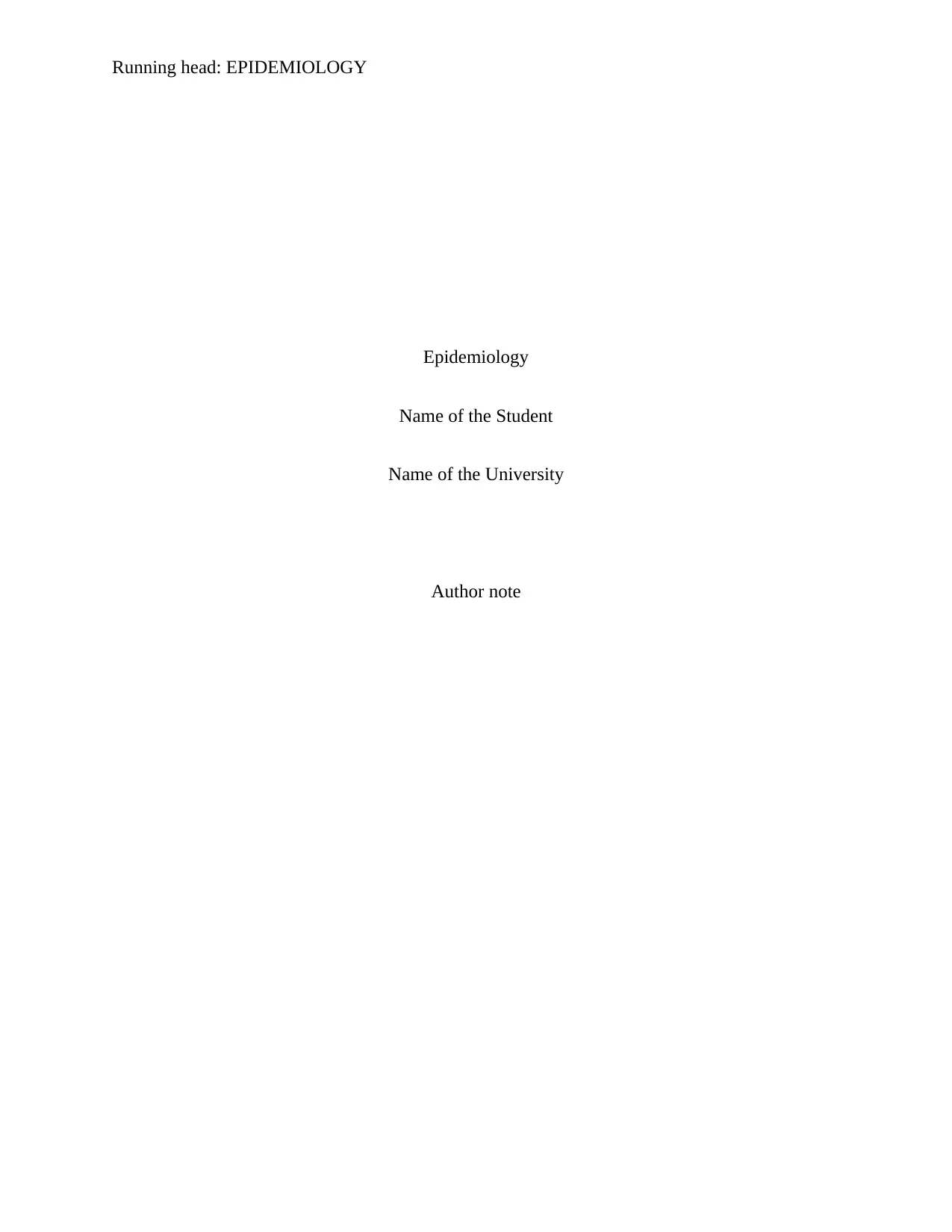
Running head: EPIDEMIOLOGY
Epidemiology
Name of the Student
Name of the University
Author note
Epidemiology
Name of the Student
Name of the University
Author note
Paraphrase This Document
Need a fresh take? Get an instant paraphrase of this document with our AI Paraphraser
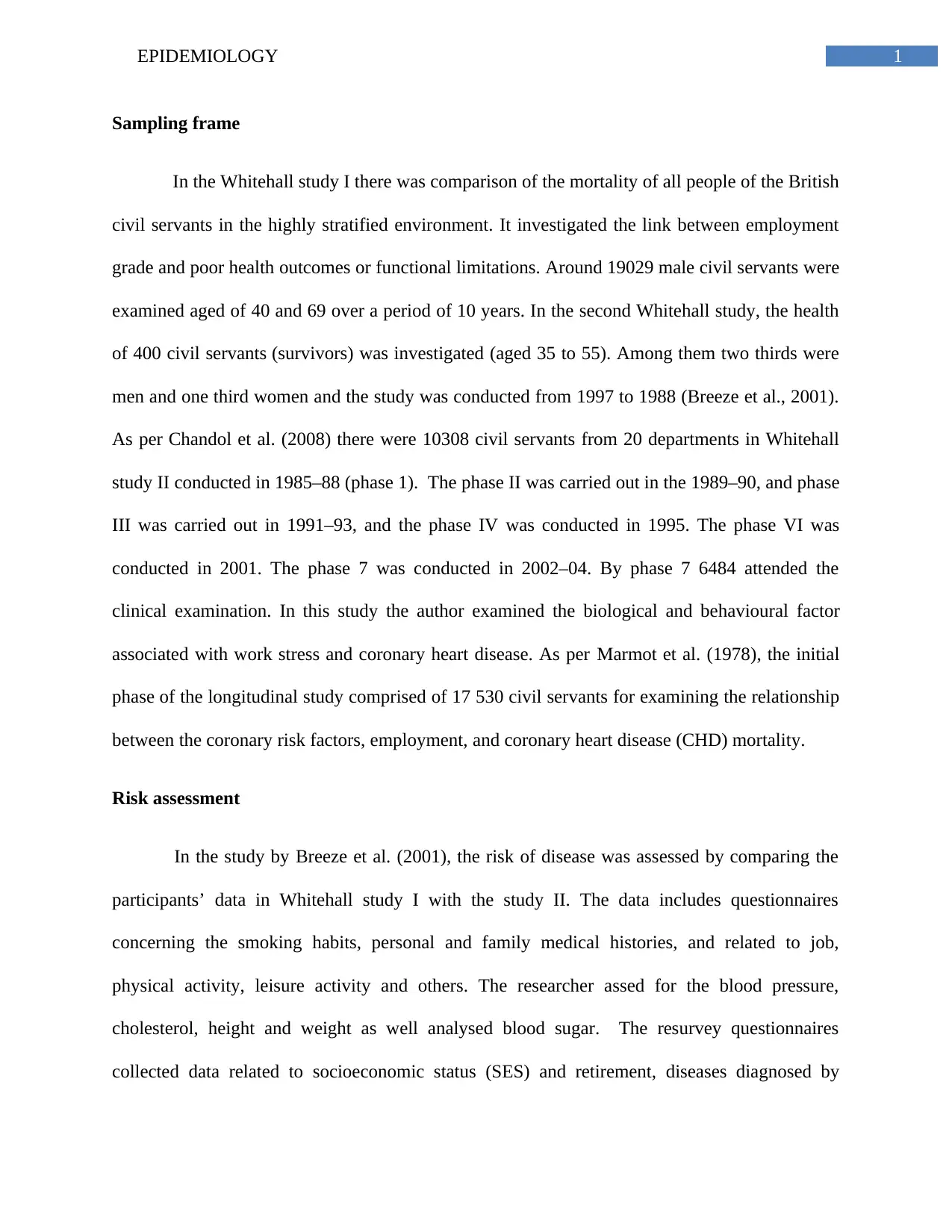
1EPIDEMIOLOGY
Sampling frame
In the Whitehall study I there was comparison of the mortality of all people of the British
civil servants in the highly stratified environment. It investigated the link between employment
grade and poor health outcomes or functional limitations. Around 19029 male civil servants were
examined aged of 40 and 69 over a period of 10 years. In the second Whitehall study, the health
of 400 civil servants (survivors) was investigated (aged 35 to 55). Among them two thirds were
men and one third women and the study was conducted from 1997 to 1988 (Breeze et al., 2001).
As per Chandol et al. (2008) there were 10308 civil servants from 20 departments in Whitehall
study II conducted in 1985–88 (phase 1). The phase II was carried out in the 1989–90, and phase
III was carried out in 1991–93, and the phase IV was conducted in 1995. The phase VI was
conducted in 2001. The phase 7 was conducted in 2002–04. By phase 7 6484 attended the
clinical examination. In this study the author examined the biological and behavioural factor
associated with work stress and coronary heart disease. As per Marmot et al. (1978), the initial
phase of the longitudinal study comprised of 17 530 civil servants for examining the relationship
between the coronary risk factors, employment, and coronary heart disease (CHD) mortality.
Risk assessment
In the study by Breeze et al. (2001), the risk of disease was assessed by comparing the
participants’ data in Whitehall study I with the study II. The data includes questionnaires
concerning the smoking habits, personal and family medical histories, and related to job,
physical activity, leisure activity and others. The researcher assed for the blood pressure,
cholesterol, height and weight as well analysed blood sugar. The resurvey questionnaires
collected data related to socioeconomic status (SES) and retirement, diseases diagnosed by
Sampling frame
In the Whitehall study I there was comparison of the mortality of all people of the British
civil servants in the highly stratified environment. It investigated the link between employment
grade and poor health outcomes or functional limitations. Around 19029 male civil servants were
examined aged of 40 and 69 over a period of 10 years. In the second Whitehall study, the health
of 400 civil servants (survivors) was investigated (aged 35 to 55). Among them two thirds were
men and one third women and the study was conducted from 1997 to 1988 (Breeze et al., 2001).
As per Chandol et al. (2008) there were 10308 civil servants from 20 departments in Whitehall
study II conducted in 1985–88 (phase 1). The phase II was carried out in the 1989–90, and phase
III was carried out in 1991–93, and the phase IV was conducted in 1995. The phase VI was
conducted in 2001. The phase 7 was conducted in 2002–04. By phase 7 6484 attended the
clinical examination. In this study the author examined the biological and behavioural factor
associated with work stress and coronary heart disease. As per Marmot et al. (1978), the initial
phase of the longitudinal study comprised of 17 530 civil servants for examining the relationship
between the coronary risk factors, employment, and coronary heart disease (CHD) mortality.
Risk assessment
In the study by Breeze et al. (2001), the risk of disease was assessed by comparing the
participants’ data in Whitehall study I with the study II. The data includes questionnaires
concerning the smoking habits, personal and family medical histories, and related to job,
physical activity, leisure activity and others. The researcher assed for the blood pressure,
cholesterol, height and weight as well analysed blood sugar. The resurvey questionnaires
collected data related to socioeconomic status (SES) and retirement, diseases diagnosed by
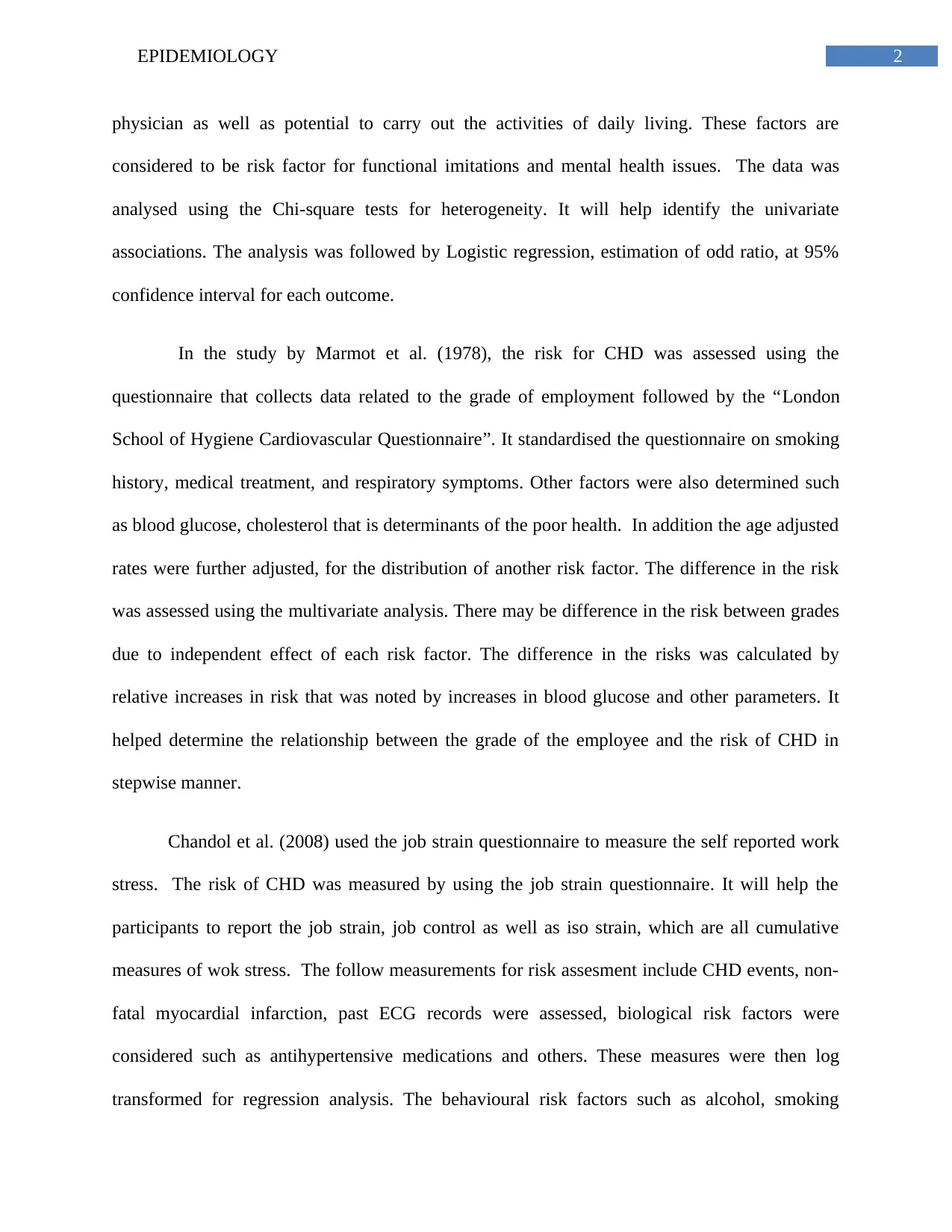
2EPIDEMIOLOGY
physician as well as potential to carry out the activities of daily living. These factors are
considered to be risk factor for functional imitations and mental health issues. The data was
analysed using the Chi-square tests for heterogeneity. It will help identify the univariate
associations. The analysis was followed by Logistic regression, estimation of odd ratio, at 95%
confidence interval for each outcome.
In the study by Marmot et al. (1978), the risk for CHD was assessed using the
questionnaire that collects data related to the grade of employment followed by the “London
School of Hygiene Cardiovascular Questionnaire”. It standardised the questionnaire on smoking
history, medical treatment, and respiratory symptoms. Other factors were also determined such
as blood glucose, cholesterol that is determinants of the poor health. In addition the age adjusted
rates were further adjusted, for the distribution of another risk factor. The difference in the risk
was assessed using the multivariate analysis. There may be difference in the risk between grades
due to independent effect of each risk factor. The difference in the risks was calculated by
relative increases in risk that was noted by increases in blood glucose and other parameters. It
helped determine the relationship between the grade of the employee and the risk of CHD in
stepwise manner.
Chandol et al. (2008) used the job strain questionnaire to measure the self reported work
stress. The risk of CHD was measured by using the job strain questionnaire. It will help the
participants to report the job strain, job control as well as iso strain, which are all cumulative
measures of wok stress. The follow measurements for risk assesment include CHD events, non-
fatal myocardial infarction, past ECG records were assessed, biological risk factors were
considered such as antihypertensive medications and others. These measures were then log
transformed for regression analysis. The behavioural risk factors such as alcohol, smoking
physician as well as potential to carry out the activities of daily living. These factors are
considered to be risk factor for functional imitations and mental health issues. The data was
analysed using the Chi-square tests for heterogeneity. It will help identify the univariate
associations. The analysis was followed by Logistic regression, estimation of odd ratio, at 95%
confidence interval for each outcome.
In the study by Marmot et al. (1978), the risk for CHD was assessed using the
questionnaire that collects data related to the grade of employment followed by the “London
School of Hygiene Cardiovascular Questionnaire”. It standardised the questionnaire on smoking
history, medical treatment, and respiratory symptoms. Other factors were also determined such
as blood glucose, cholesterol that is determinants of the poor health. In addition the age adjusted
rates were further adjusted, for the distribution of another risk factor. The difference in the risk
was assessed using the multivariate analysis. There may be difference in the risk between grades
due to independent effect of each risk factor. The difference in the risks was calculated by
relative increases in risk that was noted by increases in blood glucose and other parameters. It
helped determine the relationship between the grade of the employee and the risk of CHD in
stepwise manner.
Chandol et al. (2008) used the job strain questionnaire to measure the self reported work
stress. The risk of CHD was measured by using the job strain questionnaire. It will help the
participants to report the job strain, job control as well as iso strain, which are all cumulative
measures of wok stress. The follow measurements for risk assesment include CHD events, non-
fatal myocardial infarction, past ECG records were assessed, biological risk factors were
considered such as antihypertensive medications and others. These measures were then log
transformed for regression analysis. The behavioural risk factors such as alcohol, smoking
⊘ This is a preview!⊘
Do you want full access?
Subscribe today to unlock all pages.

Trusted by 1+ million students worldwide
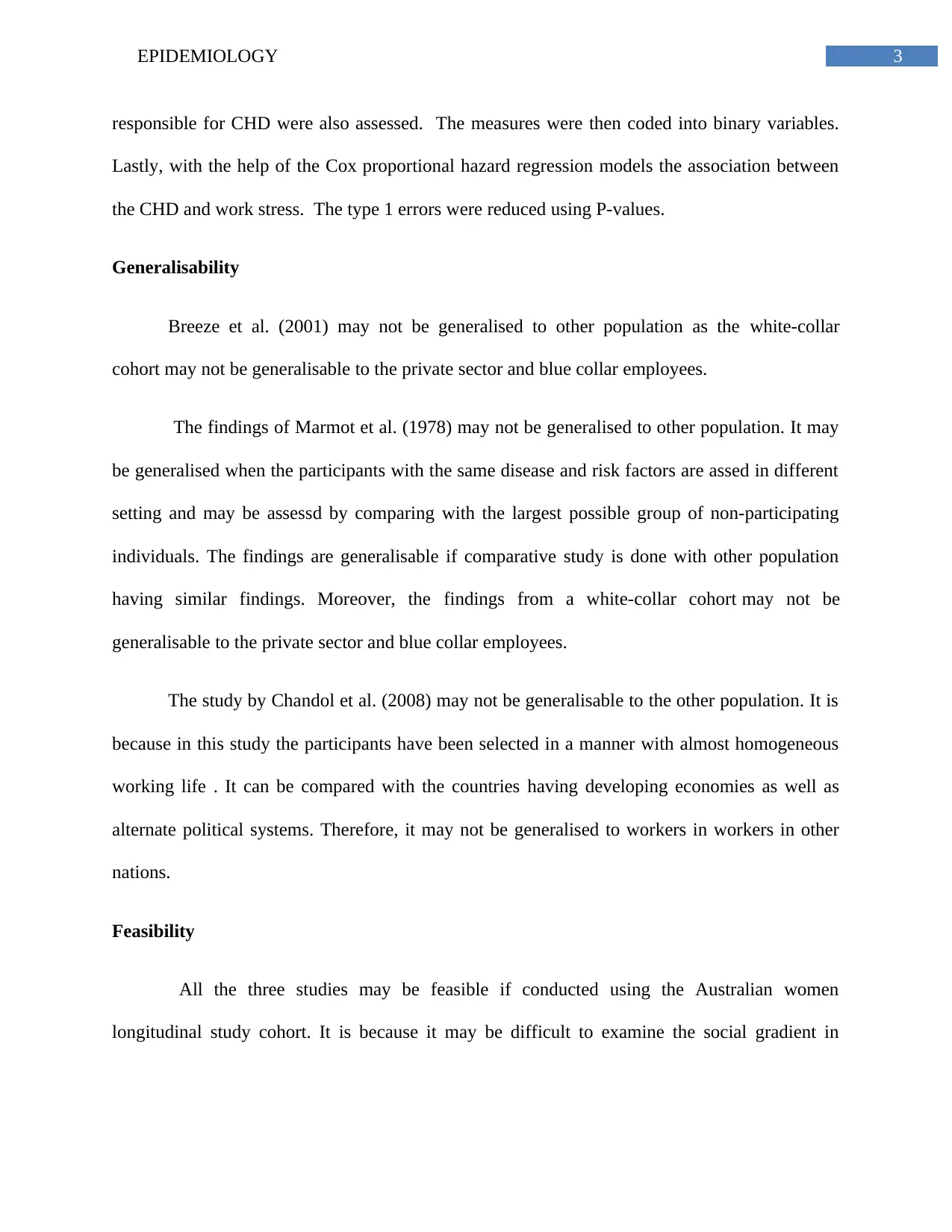
3EPIDEMIOLOGY
responsible for CHD were also assessed. The measures were then coded into binary variables.
Lastly, with the help of the Cox proportional hazard regression models the association between
the CHD and work stress. The type 1 errors were reduced using P-values.
Generalisability
Breeze et al. (2001) may not be generalised to other population as the white-collar
cohort may not be generalisable to the private sector and blue collar employees.
The findings of Marmot et al. (1978) may not be generalised to other population. It may
be generalised when the participants with the same disease and risk factors are assed in different
setting and may be assessd by comparing with the largest possible group of non-participating
individuals. The findings are generalisable if comparative study is done with other population
having similar findings. Moreover, the findings from a white-collar cohort may not be
generalisable to the private sector and blue collar employees.
The study by Chandol et al. (2008) may not be generalisable to the other population. It is
because in this study the participants have been selected in a manner with almost homogeneous
working life . It can be compared with the countries having developing economies as well as
alternate political systems. Therefore, it may not be generalised to workers in workers in other
nations.
Feasibility
All the three studies may be feasible if conducted using the Australian women
longitudinal study cohort. It is because it may be difficult to examine the social gradient in
responsible for CHD were also assessed. The measures were then coded into binary variables.
Lastly, with the help of the Cox proportional hazard regression models the association between
the CHD and work stress. The type 1 errors were reduced using P-values.
Generalisability
Breeze et al. (2001) may not be generalised to other population as the white-collar
cohort may not be generalisable to the private sector and blue collar employees.
The findings of Marmot et al. (1978) may not be generalised to other population. It may
be generalised when the participants with the same disease and risk factors are assed in different
setting and may be assessd by comparing with the largest possible group of non-participating
individuals. The findings are generalisable if comparative study is done with other population
having similar findings. Moreover, the findings from a white-collar cohort may not be
generalisable to the private sector and blue collar employees.
The study by Chandol et al. (2008) may not be generalisable to the other population. It is
because in this study the participants have been selected in a manner with almost homogeneous
working life . It can be compared with the countries having developing economies as well as
alternate political systems. Therefore, it may not be generalised to workers in workers in other
nations.
Feasibility
All the three studies may be feasible if conducted using the Australian women
longitudinal study cohort. It is because it may be difficult to examine the social gradient in
Paraphrase This Document
Need a fresh take? Get an instant paraphrase of this document with our AI Paraphraser
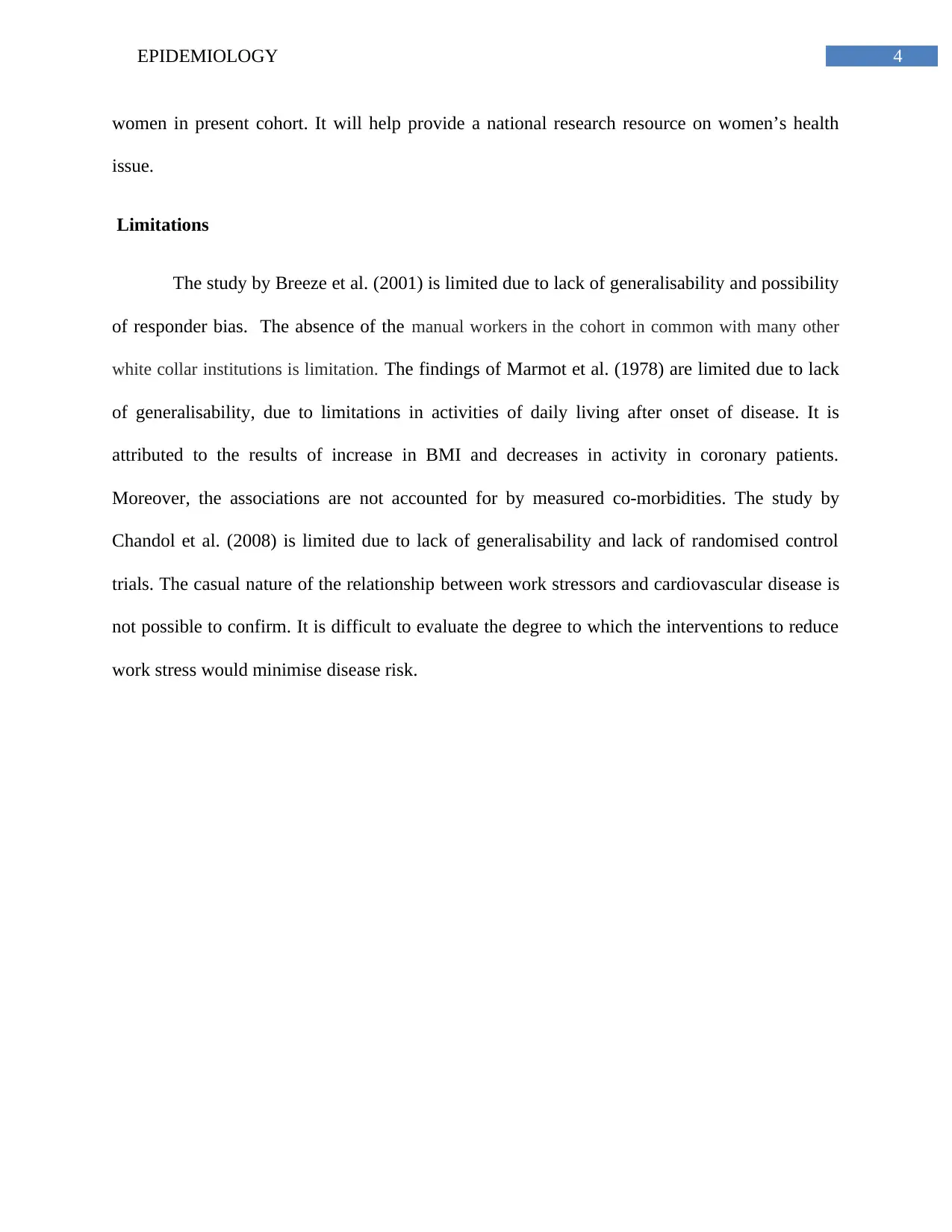
4EPIDEMIOLOGY
women in present cohort. It will help provide a national research resource on women’s health
issue.
Limitations
The study by Breeze et al. (2001) is limited due to lack of generalisability and possibility
of responder bias. The absence of the manual workers in the cohort in common with many other
white collar institutions is limitation. The findings of Marmot et al. (1978) are limited due to lack
of generalisability, due to limitations in activities of daily living after onset of disease. It is
attributed to the results of increase in BMI and decreases in activity in coronary patients.
Moreover, the associations are not accounted for by measured co-morbidities. The study by
Chandol et al. (2008) is limited due to lack of generalisability and lack of randomised control
trials. The casual nature of the relationship between work stressors and cardiovascular disease is
not possible to confirm. It is difficult to evaluate the degree to which the interventions to reduce
work stress would minimise disease risk.
women in present cohort. It will help provide a national research resource on women’s health
issue.
Limitations
The study by Breeze et al. (2001) is limited due to lack of generalisability and possibility
of responder bias. The absence of the manual workers in the cohort in common with many other
white collar institutions is limitation. The findings of Marmot et al. (1978) are limited due to lack
of generalisability, due to limitations in activities of daily living after onset of disease. It is
attributed to the results of increase in BMI and decreases in activity in coronary patients.
Moreover, the associations are not accounted for by measured co-morbidities. The study by
Chandol et al. (2008) is limited due to lack of generalisability and lack of randomised control
trials. The casual nature of the relationship between work stressors and cardiovascular disease is
not possible to confirm. It is difficult to evaluate the degree to which the interventions to reduce
work stress would minimise disease risk.
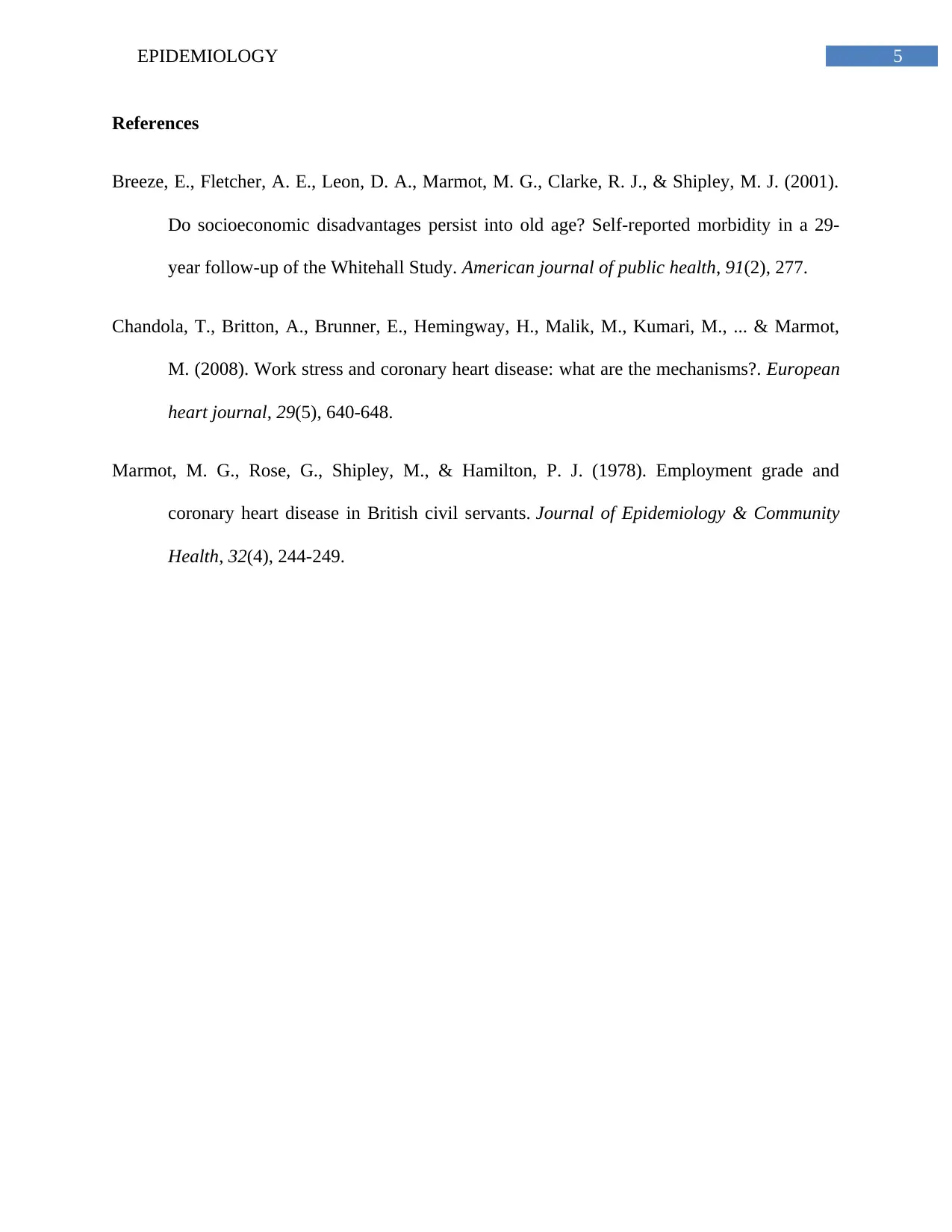
5EPIDEMIOLOGY
References
Breeze, E., Fletcher, A. E., Leon, D. A., Marmot, M. G., Clarke, R. J., & Shipley, M. J. (2001).
Do socioeconomic disadvantages persist into old age? Self-reported morbidity in a 29-
year follow-up of the Whitehall Study. American journal of public health, 91(2), 277.
Chandola, T., Britton, A., Brunner, E., Hemingway, H., Malik, M., Kumari, M., ... & Marmot,
M. (2008). Work stress and coronary heart disease: what are the mechanisms?. European
heart journal, 29(5), 640-648.
Marmot, M. G., Rose, G., Shipley, M., & Hamilton, P. J. (1978). Employment grade and
coronary heart disease in British civil servants. Journal of Epidemiology & Community
Health, 32(4), 244-249.
References
Breeze, E., Fletcher, A. E., Leon, D. A., Marmot, M. G., Clarke, R. J., & Shipley, M. J. (2001).
Do socioeconomic disadvantages persist into old age? Self-reported morbidity in a 29-
year follow-up of the Whitehall Study. American journal of public health, 91(2), 277.
Chandola, T., Britton, A., Brunner, E., Hemingway, H., Malik, M., Kumari, M., ... & Marmot,
M. (2008). Work stress and coronary heart disease: what are the mechanisms?. European
heart journal, 29(5), 640-648.
Marmot, M. G., Rose, G., Shipley, M., & Hamilton, P. J. (1978). Employment grade and
coronary heart disease in British civil servants. Journal of Epidemiology & Community
Health, 32(4), 244-249.
⊘ This is a preview!⊘
Do you want full access?
Subscribe today to unlock all pages.

Trusted by 1+ million students worldwide
1 out of 6
Related Documents
Your All-in-One AI-Powered Toolkit for Academic Success.
+13062052269
info@desklib.com
Available 24*7 on WhatsApp / Email
![[object Object]](/_next/static/media/star-bottom.7253800d.svg)
Unlock your academic potential
Copyright © 2020–2025 A2Z Services. All Rights Reserved. Developed and managed by ZUCOL.





